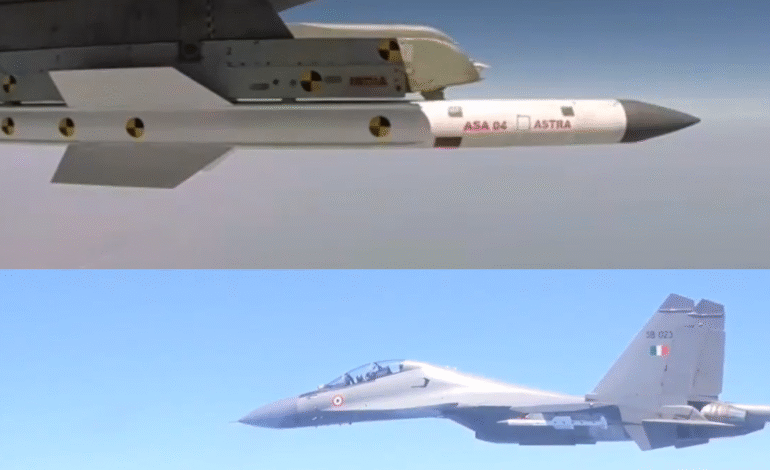India’s Astra Missile Test Boosts Indigenous Defence with Pinpoint Accuracy

India marked a significant milestone in its defence journey with the successful testing of its homegrown Astra Beyond Visual Range Air-to-Air Missile (BVRAAM) equipped with an indigenous Radio Frequency (RF) Seeker. Conducted on a Su-30MKI fighter jet, the test took place off the coast of Odisha and is seen as a vital leap forward in self-reliant defence technology, reinforcing India’s capabilities in the aerospace and missile development domain.
This mission, involving two precise test launches, showcased Astra’s lethal accuracy and technological maturity. The development, overseen by the Defence Research and Development Organisation (DRDO) in partnership with the Indian Air Force (IAF), places India among the few countries with indigenous BVR air-to-air missile systems and proprietary RF seeker technology.
Let’s dive deep into how this successful test not only strengthens India’s military edge but also highlights the power of homegrown innovation in critical defence systems.
A Successful Test Demonstrates Power and Precision
On a bright Friday morning, Astra soared across the skies over Odisha, achieving two flawless launches against high-speed aerial targets. Fired from the powerful Su-30MKI combat platform, both test rounds demonstrated the missile’s remarkable ability to destroy targets at varying distances and angles.
Each missile hit its mark with pinpoint accuracy, confirming the effectiveness of India’s home-built RF Seeker – a technology central to guiding the missile once it locks on to its target. In both launches, the conditions were varied to assess the performance of the missile under multiple combat scenarios.
The Indian Air Force and DRDO confirmed that all sub-systems functioned as expected, and the flight data gathered by range tracking instruments at the Integrated Test Range (ITR), Chandipur, validated the missile’s superior performance. The seamless synergy between the launch platform and the seeker-guided missile highlighted India’s growing expertise in aerospace engineering and high-precision weaponry.
Astra Missile: India’s Indigenous Beyond Visual Range Game-Changer
The Astra missile program has evolved over the years to meet India’s demand for air-to-air superiority weapons that can outperform enemy aircraft without direct visual contact. The term “Beyond Visual Range” (BVR) refers to the ability of the missile to strike aerial targets over long distances in Astra’s case, beyond 100 kilometres.
Such technology enables fighter jets like the Su-30MKI to lock onto and eliminate threats before the enemy aircraft can retaliate. This ability grants the IAF an operational edge in combat scenarios, reducing risk while maintaining control over contested airspace.
India’s Defence Minister Rajnath Singh called the successful test a “major milestone,” emphasizing that the development of the indigenous seeker strengthens India’s self-reliance in critical defence technologies.
Significance of Indigenous Radio Frequency Seeker
One of the key technological achievements of this test was the validation of an Indian-made Radio Frequency (RF) seeker. This is the part of the missile that detects and tracks the target using radio waves, ensuring accurate terminal guidance
Why is this significant?
Traditionally, India relied on imported RF seekers, which not only incurred high costs but also exposed supply chains to geopolitical uncertainties like export bans or price manipulation. Now, with the seeker developed by DRDO, India owns the core intellectual property and production capability of this critical subsystem.
This independence protects the defence ecosystem from external disruption and provides the freedom to evolve and adapt seeker technology in alignment with future threats.
Moreover, the indigenous seeker contributes to reducing costs and opens avenues for future exports, aligning with India’s vision of becoming a global defence supplier under the “Atmanirbhar Bharat” (Self-Reliant India) initiative.
Strategic Impact for the Indian Air Force and Navy
The Astra missile isn’t just a technological marvel—it’s a strategic asset. With a range of more than 100 kilometres and the capability to operate under diverse combat conditions, it is set to become a standard weapon on India’s frontline fighters like the Su-30MKI, as well as upcoming indigenous jets like Tejas Mk-2.
Back in 2021, the Ministry of Defence signed a ₹2,971 crore contract with Bharat Dynamics Limited (BDL) in Hyderabad for the production of Astra Mk-1 missiles and launchers. These units will serve both the Indian Air Force and the Indian Navy, making Astra a cross-platform weapon suitable for a variety of operational theatres.
This also aligns with India’s focus on maritime security, as the Navy’s air wings will benefit from the enhanced defensive and offensive capabilities offered by the Astra system.
Looking Ahead: Astra Mk-2 and Extended Range Capabilities
While Astra Mk-1 is already establishing itself as a mainstay in Indian aerial defence, DRDO scientists are actively developing Astra Mk-2, a more advanced version with an extended range of approximately 140 kilometres.
Expected to complete developmental trials by 2026, the Mk-2 variant aims to further widen the engagement envelope, improve speed and reliability, and offer multi-platform compatibility. With such enhancements, the Astra family is poised to match global leaders in air-to-air missile technology, including systems like the American AIM-120 AMRAAM and the European Meteor.
The development of Astra Mk-2 will also likely introduce upgrades in seeker performance, data link functionality, and kinetic efficiency pushing the boundaries of what indigenous defence tech can achieve.
Global Context: Astra and India’s Rising Defence Exports
India’s successful test of the Astra missile with an indigenous seeker places it on a shortlist of nations with advanced BVRAAM programs developed entirely within national borders. Countries like the United States, Russia, France, and China have historically dominated this space.
However, with a successful indigenous system in place, India is now eyeing defence exports in this domain. Several Southeast Asian, Middle Eastern, and African nations are modernising their air forces, and Astra could find buyers among countries seeking cost-effective and reliable alternatives to Western or Chinese systems.
For the Middle East, in particular, the need for dependable, scalable, and autonomous air-defence systems is growing, and India’s rising capabilities may attract attention from UAE, Saudi Arabia, and other nations aiming to diversify their defence procurement strategies.
With consistent test success, robust supply lines through Bharat Dynamics Limited, and long-term sustainability ensured by DRDO, Astra has the potential to become a commercial success story as well.
UAE and India: Defence Ties Growing Stronger
India’s progress in indigenous missile technology could also strengthen its bilateral defence ties with the UAE and other Gulf nations. Over the past few years, India and the UAE have increased joint exercises, technology exchanges, and security dialogues.
Defence systems like Astra could become a focal point for cooperation in areas like aerospace research, missile testing environments, and counter-drone technologies. As the UAE also expands its air force capabilities, indigenous missiles from India might serve as viable options for strategic cooperation.
With Expo 2020 and various defence expos held in Abu Dhabi and Dubai, India has already exhibited its capabilities on global platforms. Astra’s successful indigenous development and test might now take centre stage at future exhibitions, strengthening India’s positioning as a tech leader in the region.
India’s Technological Leap Reflects a Global Strategic Vision
The recent Astra missile test with an indigenous RF seeker is more than just a weapons trial it’s a testament to India’s evolving strategic vision. It combines defence preparedness with self-reliance, technical mastery with combat efficiency, and innovation with export potential.
As DRDO continues to build on this success and gear up for the launch of Astra Mk-2, India’s missile ecosystem stands on the threshold of global competitiveness. The broader implications for defence security, diplomacy, and economic growth are profound highlighting how critical innovation in aerospace is not just a national necessity but a global opportunity.
The journey of Astra from prototype to battlefield-ready missile shows the power of vision, collaboration, and resilience. In a time where air superiority determines the outcome of conflicts, Astra is India’s answer to building a secure and self-sufficient future in aerospace warfare








4 Comments
[…] long-term thinking has paid off. Today, UAE fighters are respected around the world for their discipline, sportsmanship, and technical precision […]
[…] Sheikh Hamdan’s leadership, the UAE has amplified its defence diplomacy, fostering stronger ties with regional and global partners. His participation in the 21st GCC Joint […]
[…] missiles Prithvi-II and Agni-I on July 17, 2025. These test launches, carried out from the Integrated Test Range in Odisha, were overseen by the Strategic Forces Command (SFC), which manages India’s nuclear […]
[…] ambitious project aligns with India’s strategic vision to establish a dominant maritime presence in the Indo-Pacific region, while simultaneously […]
Comments are closed.